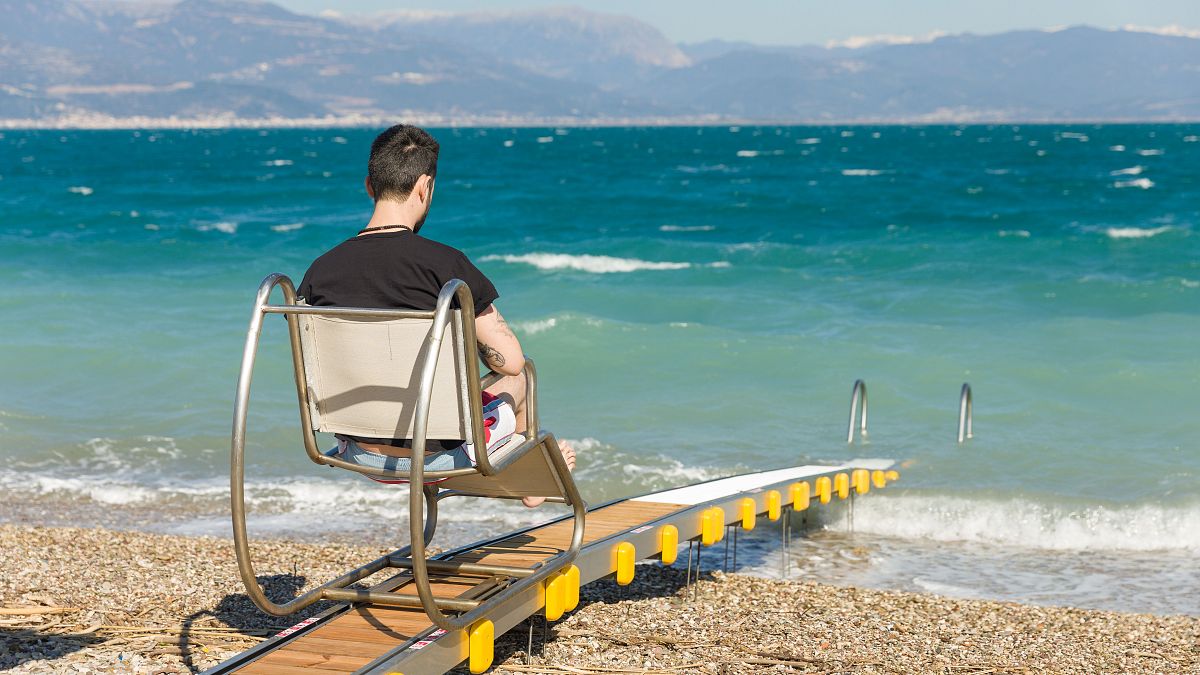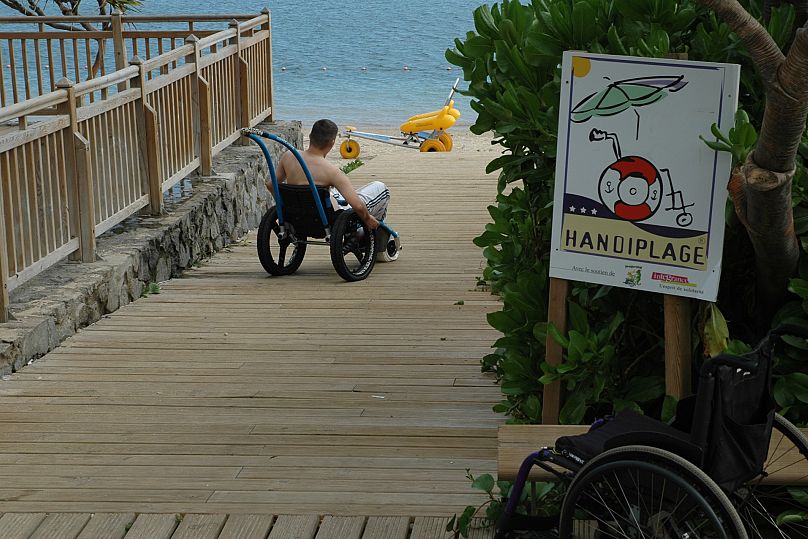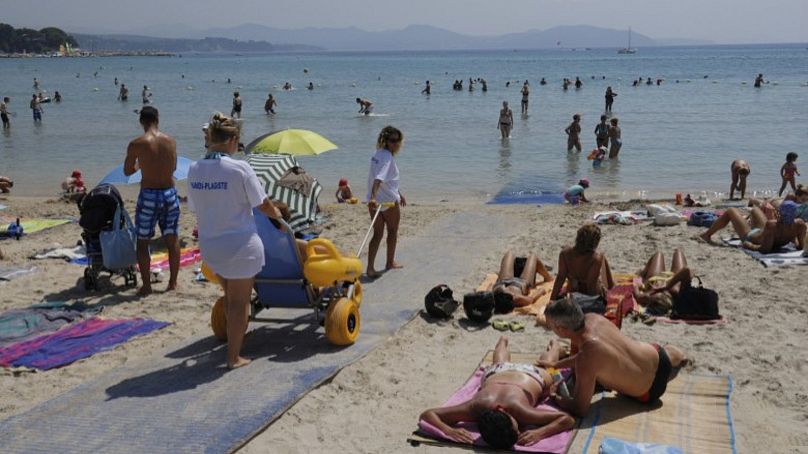Although there have been some improvements, people with disabilities still face challenges in accessing beaches in Europe. Meet the people fighting to make beaches accessible to all.
"When I was a kid, I was going every single day to the beach," Brigitte Berckmans, 54, remembers.
Having grown up in Les Landes, a department in southwestern France along the Atlantic coastline, her parents would carry her to the beach because of her disability. As she grew up, it became more difficult to take a dip in her beloved ocean.
Her husband, Ramón Espi, who became disabled at 27 following a motorbike accident, used to spend every summer at the beach, too.
In fact, the beach is where they met. "Living on the Basque coast, everyone was going to the beach, but we couldn't. Our encounter was the trigger," Espi, now 62, told Euronews.
The pair launched their association Handiplage in Bayonne in 1997 to fight for the integration of people with disabilities and beach accessibility.
"Thousands of people with disabilities go to the beach each summer. They are with able-bodied people so it favours the integration of persons with disabilities thanks to the beach and recreational activities," Espi explained.
In 2022, more than one-quarter (27.0 %) of the EU population aged 16 and over had a disability or an activity limitation, according to Eurostat.
Since 2002, Handiplage has notably delivered a five-year label to municipalities to make beaches accessible to people with disabilities and improve their safety during swims.
The first level of accessibility requires an aid station, an access ramp, adapted sanitary facilities, parking spots, and an amphibian engine to grant access to the water.
To access levels 2 and 3, adapted showers are required on-site, and "handiplagistes," or bathing guides trained by the association, need to be on-site to assist people with disabilities entering and exiting the sea.
The highest level 4 rewards beaches, which also offer devices for visually impaired people.
By July, 140 beaches received the Handiplage label in France.
Some regions' terrain makes it more challenging to make beaches accessible. On some beaches, access is also only possible at low tide.
"We had a lot of difficulty getting open beaches on the coast of Landes (in southwestern France) because of the dunes there," Espi explained.
"We thought beaches in Brittany (would remain) inaccessible. But when there's a will, there's a way. There are always solutions," he added.
On the flip side, it was easier to make beaches accessible on the French Riviera since the tide is insignificant and there are almost no waves.
However, the two also encountered administrative challenges. "You have to find the right person. The mayor changes every five years. And in general, the municipal accessibility advisor also changes with the team," Berckmans told Euronews.
The change in local government means that the association has to keep an eye on the beaches to ensure municipalities maintain the amenities once they have received the label.
"Municipalities do a lot to enable people with disabilities to exit their homes, to work, to have access to leisure or sports (...) Everything is done to integrate people with disabilities into the society," said Espi.
"But when it comes to access to beaches, we took the bull by the horns, and we have been the ones holding the horns since then."
A bathing chair initiative picks up speed
Beyond associations and local authorities, universities and companies also contribute to solutions.
The University of Patras and Greek company Tobea crafted a specific device for people with disabilities: the free-of-charge Seatrac bathing chairs.
"Seatrac is a device that actually connects the shore with the water," Persefoni Bertzou, Tobea's marketing manager, told Euronews.
Thanks to a walkway, people with disabilities can access the Seatrac with their wheelchairs on the beach. After embarking on the Seatrac bathing chair, they can use a remote control to access and exit the sea independently via a set of tracks.
"Seatrac was an (important) innovation because it was the only device allowing a paraplegic person, for example, to go and swim on their own," Bertzou said.
Since 2012, the company has installed 250 Seatracs on different beaches in Greece, Italy, Cyprus, Croatia, Lithuania, and Latvia. And the need is clearly there: by 2023, the chairs were used more than 400,000 times, according to Tobea.
The basic setup includes parking spaces, a walkway, a Seatrac to go into and out of the water, and a changing room.
The users' feedback was important, too. Showers were installed so as not to damage wheelchairs with seawater.
People also asked for a shaded area and a way to see the beach conditions before going to the beach to avoid waves and crowds. So, a camera was installed on the track to have a live view of the beach. However, to be GDPR-compliant, the system blurs people's faces.
"There are so many different needs and so many different demands," Bertzou explained. "What we have learned is that if you want to create something and say it is accessible, you need the opinion and the knowledge of the people that use it."
"(Another) problem is that we have to face different bureaucratic procedures because of different laws and legislations in every country," she added.
In Greece, the municipalities are Seatrac's main customers since all beaches are public. In Italy, their clients also include beach operators renting parts of the beach from the municipalities.
The 2008 UN Convention on the Rights of Persons with Disabilities requires everyone to be afforded equal access to participate in cultural life, recreation, leisure and sport.
The European Disability Strategy 2010–20, adopted in 2010, notably aims to make goods and services accessible to people with disabilities, remove barriers to equal participation in public life and leisure activities, and promote the provision of quality community-based services.
This means that someone else has to pick up the tab for the chairs, helping people with disabilities reach the sea for free, according to Bertzou.
"Seatracs must be free of charge for the users because these are human rights: to use the sea, to swim," she concluded.















